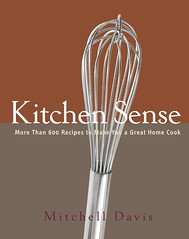 Kitchen Sense: More Than 600 Recipes to Make You a Great Home Cook
Kitchen Sense: More Than 600 Recipes to Make You a Great Home CookBy Mitchell Davis
Clarkson Potter Publishers, New York City
Hardcover; 516 pages; C$50/US$35
ISBN-10: 1-4000-4906-7
One thing that struck me when I collected Kitchen Sense was one line from the marketing team:
"…Kitchen Sense is like cooking alongside the Italian-Midwestern-Thai-Hungarian-Mexican-Southern-French-Israeli-Yankee-Indian grandmother you never had."Them's tough words to live up to.
Mitchell Davis isn't a culinary lightweight. He's the vice president and director of communications for The James Beard Foundation, an adjunct professor and PhD candidate at NYU's food studies program. He’s penned two other cookbooks (The Mensch Chef, Cook Something and co-wrote Fois Gras: A Passion) and wrote for GQ Magazine and Food & Wine. Did I mention he grew up in Toronto, trained as a chef in France and Italy and now lives in NYC? Yup...if someone should guide a novice cook by the hand, he is a very good candidate.
I don't think I'm that atypical in how I approach a cookbook. I read it as a novel, starting at page one carrying through to the index. It should lead me through a path that's either familiar, unfamiliar or a little of both, depending upon what I want it to do. I need to feel the author's personality and presence--as if they were sitting in my kitchen chair, glass of pinot noir in hand, imparting advice and opinion based on experience or some esoteric-to-me knowledge. I dread cookbooks that are devoid of the author's humanity or worse yet, are merely a gaggle of vaguely themed recipes, all bunged together under a cover.
Davis delivers a readable book. His introduction lets you glimpse whom and why he is. He and I are cut from similar cloth and believe food isn’t to be feared, but embraced, lived with, learnt about and enjoyed. As he says
"…the most effective way to accomplish all of that is to cook."
The book is generalist cookery, attempting to capture little bits of everything for everyone. It houses the basics of North American cooking (meatloaf, tomato sauce, mac’n’cheese) but also reflects what American tastes are evolving into—a sampler dish, if you will, of international cuisines such as Indian, Mexican and Thai.
Meandering through its leaves, I feel as if I’m partaking in a hearty and elaborate feast that begins at midnight and lasts a full 24 hours or longer. Beginning with a chapter on starters (Hors d'Oeuvres, Spreads, Dips and Other Finger Foods), Kitchen Sense outlines soups, salads, sandwiches, brekkie, veggies, grains & pastas, fish & shellfish, poultry, meats, sauces & condiments, and ends with desserts. I think of each section’s introduction as pouring the next glass: that little break between conversations, where one gathers his or her thoughts for the next discourse.
I particularly like how Davis sets his recipe pages. Introductions are part opinion, part anecdote and part advice. Within his ingredient list, he references other recipes or methods for the uninitiated (how to toast cumin seeds, poach eggs or make a red sauce). He studs the technique with suggestions and ends with notes on cooking and prep times, along with hints and tips regarding variations, advance prep and leftovers. Many pages feature a few paragraphs about quandaries such as undercooked eggs, grilling pizza and turkey de-mystification.
But the feast itself doesn't end there.
After all those recipes and sidebars, he gives us three important but often forgotten sections: Understanding the recipes in this book; Kitchen words, and Further reading. These sections are written for normal people-not those with home economics degrees, nor enrolled at culinary school.
There are a few quirks to this book which I simply can't overlook. I had issues with preparation times, usually needing to add an extra 25-50 per cent to whatever was published (see my recipe notes below). Also, being written for Americans, its measurements are embedded with sticks of butter and cups of rice. Without any sort of conversion table, this book may not translate well to an international audience accustomed to measuring in grams and litres, weighing flour for cakes, or using pints for milk (or better yet beer).
What many will immediately notice is the book, all 500+ pages of it, is picture-less. Some may see this as a detriment (especially if you want a beautifully glossy cookbook, filled with supermodels from the gastroporn world) but I see this as a plus. By avoiding illustrations, I think Davis focuses on what cooking should be: the food's flavour and cooking technique.
To be honest, I know this book wasn't written for me (which is good because any publisher venturing to do that would go bankrupt in a week). It was written for the novice American cook--"the lost generation" whose mums and grandmas didn’t explain the ins and outs of simmering or pie making, and may never have taken a real home-ec class. Kitchen Sense is handy for someone taking their first few precarious steps into the kitchen or a new part of the grocery store- a uni student/recent grad fending for themselves or someone who wants to try a style of cooking different to the same-old, same-old.
Sara asked that we each prepare one dish.
Sara and Cath, please forgive me. I couldn't stop at just one. I tried four.
There's a method to my madness (believe it or not)-I wanted to try something I do often, something I do every once in a while, something I haven't done in years, and a soup. For me, this was the best way to get a feel for the book. In general, everything was easy to prepare and tasted great.
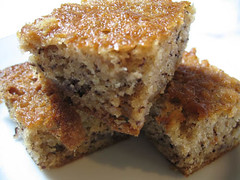 Banana Cake (p444)
Banana Cake (p444)I make between 10 and 20 banana breads annually and always want to try a new recipe. Mine needed longer in the oven as I use glass bakeware and I think Davis uses metal. This one produces an amazingly moist crumb that's not too sweet. Some who tried it wanted to know what the magic ingredient was. The answer: buttermilk.
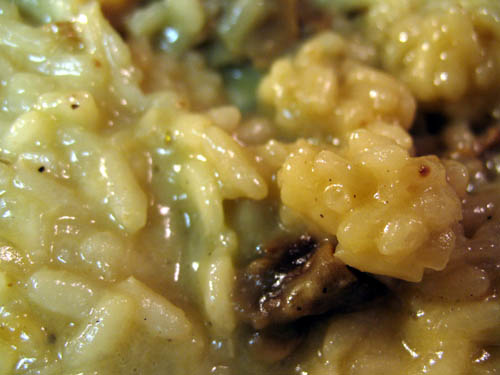 Porcini Risotto (p224)
Porcini Risotto (p224)I usually make this a couple of times a year. It was creamy and had a lovely woodsy taste from the rehabilitated fungi. Davis’ instructions were well-written and easy to follow.
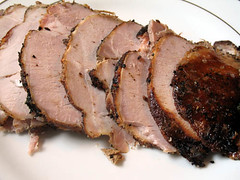 Roast Pork, Tuscan-Style (p372)
Roast Pork, Tuscan-Style (p372)I must admit that I rarely eat or roast pork. If you try this dish, get your meat from a butcher that sells unadulterated pork or cut down on the salt if you buy pre-brined (or “seasoned”) meat otherwise this dish will give the Dead Sea a run for its money in saltiness. Davis' instruction to "turn the heat down as low as it will go" was problematic as it seems my hob sets to a lower flame than his. I recommend turning the flame to a good simmer (say a 3.5 on a scale of 10 with 10 being full blast). With these minor adjustments, this is a lovely, flavourful way to roast meat in summer’s heat.
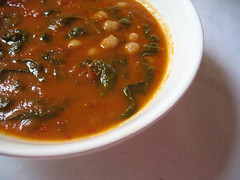 Roasted Tomato Soup with Chickpeas, Spinach and Cumin (p36)
Roasted Tomato Soup with Chickpeas, Spinach and Cumin (p36)My dear friend told me that the way to judge a cook is by his soup. There are many good recipes to choose from, but this one spoke to me. The roasted tomatoes lend a bright, smoky sweetness that’s counterbalanced by the tart lemon juice, and sparked by cumin. Add to this the contrast of the pureed tomatoes against the chunky, chickpeas and wilted spinach and this is a wonderful soup, summer or winter, hot or cold. I found the lemon juice a bit heavy, so next time I’ll reduce the juice by half.
cheers!
jasmine
Related Posts:
Cookbook Spotlight: Kitchen Sense Round-Up Part One
Cookbook Spotlight: Kitchen Sense Round-Up Part Two
tags:CookbookSpotlight: Kitchen Sense

10 comments:
wow!! you sure cooked up a storm, looks great!
Wow, Jasmine!
You have outdone yourself. Everything looks and sounds delicious.
Wish I could have been there to enjoy it all with you!
A lot of work went into this great review! Nice job Jasmine!
Jasmine, I must check this out as all your creations look wonderful - great post!
Hello All!
Kat - I did and my friends are very happy for it :)
Ivonne - Thank you so much! One of these days, when we get the same book again, we should do a feast of some sort either here or in TO :)
Joe - Welcome! Your kind words mean a lot.
Paz - Glad you liked it. It's now available for sale, so take a boo through its pages...
Keiko - I don't know if it will be available in the UK, and as I said, there's no conversion charts. Clarkson Potter is part of Random House. If you can't find it at Waterstone's or WH Smith, try amazon.com (not .co.uk).
j
I just adore banana bread and yours looks so soft and moist, its best that way!
And this now explains to me why all these food bloggers have the same cookbook. I thought it was just a massive coincidence. I better get with the program...
A logical way to analyze a cookbook. I am very impressed.
I think I like the soup and risotto the best!
Beautiful write up.
Hello
Jenjen: it was an amazing cake. I'd never thought that buttermilk would have done that!
Tanna: Glad you like the review!
j
Great review Jasmine. Thanks for dropping by my site. I think I'll be trying the Risotto. Yours does look good.
Jasmine, your writing is as beautiful as your creations. Thank you for such a nice compliment on my review of the book.. but I feel that yours was simply stunning. Even after going through my own book and making my own opinion of it (which didn't veer too far from yours), I feel a brand new sense for the book after reading your review. Just awesome! I also loved your choices of recipes to make and although they all look delicious, I so want to try that soup! hehe
I so enjoy your blog.. thanks so much for sharing with the rest of us! =)
Post a Comment